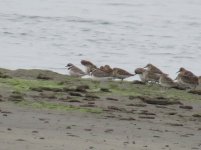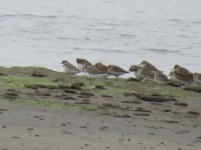DoghouseRiley
Well-known member
Hi All
Got here very late, poor light and low tide. Took some long distance shots just in case I could pick out anything interesting later.
Could you look at the plover, second left? Furthest left looks like a Ringed Plover to me, but the other one looks different. Looks like a female Kentish. Pale mark above the eye, no dark markings to the head, paler collar than the other Plover there.
Maybe the picture isn't good enough to ID?
Yours
Gareth
Got here very late, poor light and low tide. Took some long distance shots just in case I could pick out anything interesting later.
Could you look at the plover, second left? Furthest left looks like a Ringed Plover to me, but the other one looks different. Looks like a female Kentish. Pale mark above the eye, no dark markings to the head, paler collar than the other Plover there.
Maybe the picture isn't good enough to ID?
Yours
Gareth





